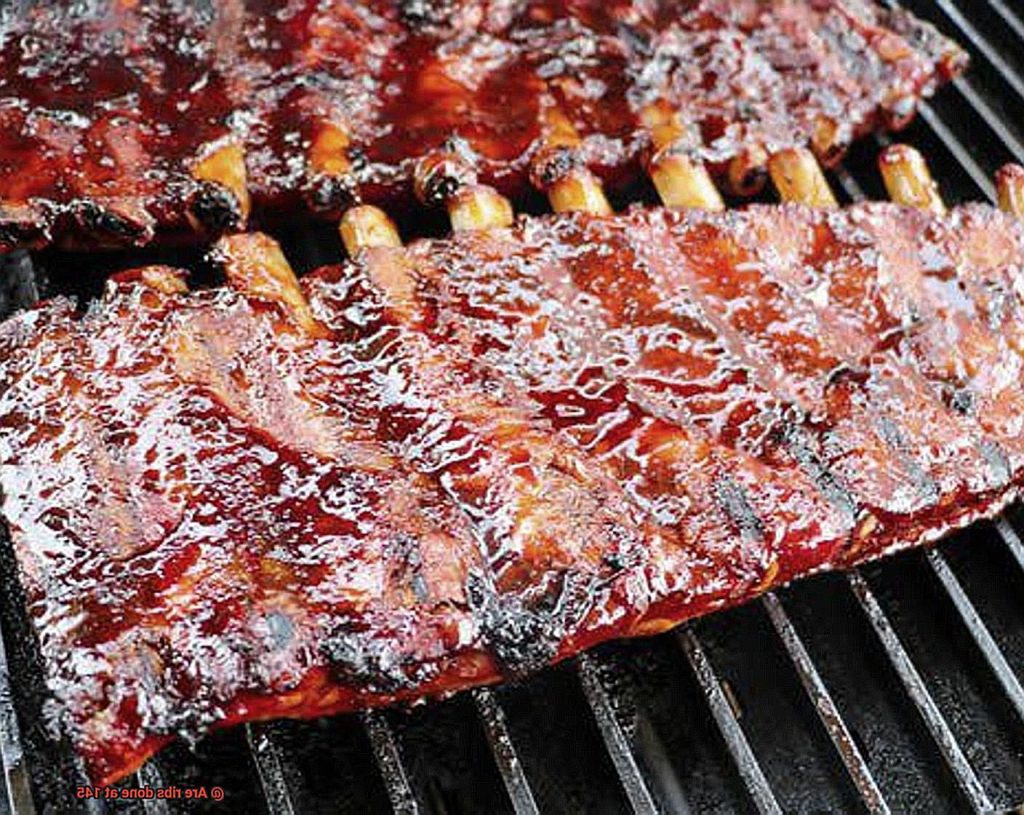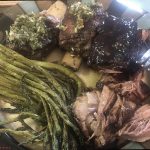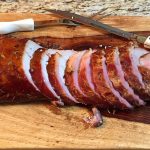Step into the sizzling world of rib perfection.
Picture this: your taste buds on high alert, eagerly anticipating the arrival of succulent, mouthwatering ribs straight from the grill. But here’s the million-dollar question that sparks fiery debates among grill masters and pitmasters everywhere: are ribs done at 145 degrees Fahrenheit?
Brace yourself, because the answer may just knock your socks off. In this tantalizing journey, we’ll dive deep into the realm of rib-cooking temperatures and separate barbecue fact from fiction.
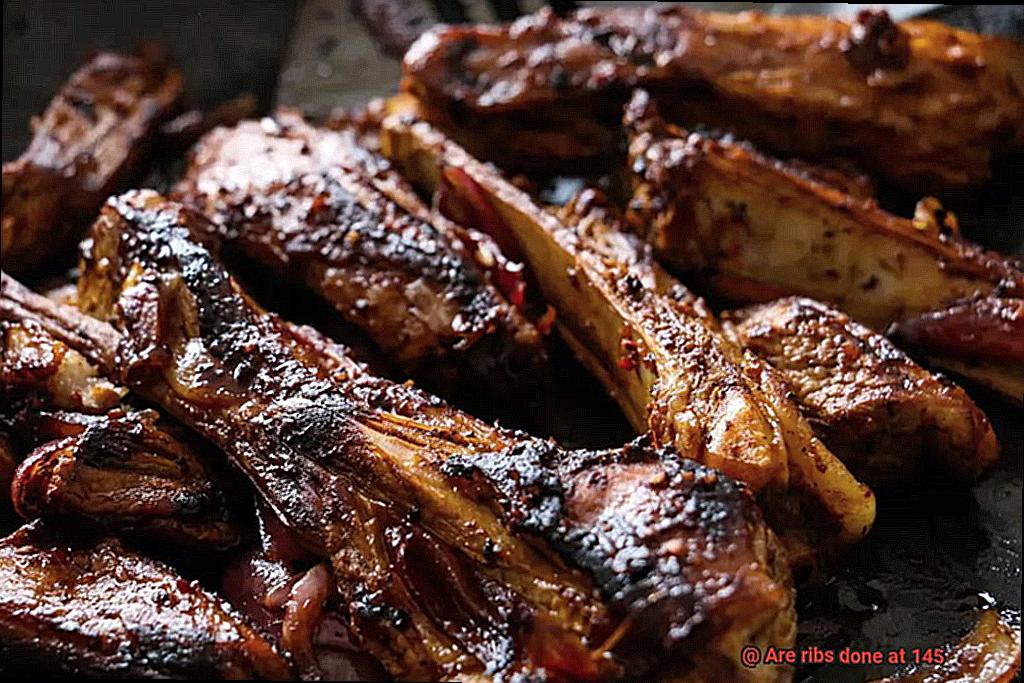
Get ready for a lip-smacking adventure like no other.
Contents
Is 145°F Enough to Ensure Ribs are Safe to Eat?
When it comes to cooking ribs, ensuring they reach a safe internal temperature is just the tip of the meaty iceberg. While 145°F is the minimum safe temperature for pork, including ribs, it falls short of guaranteeing tender and flavorful ribs. To achieve that mouthwatering, fall-off-the-bone deliciousness, you’ll need to crank up the heat.
Ribs are a tough cut of meat that demand a low and slow approach. Cooking them at a higher temperature, around 180-200°F, for an extended period of time is key. This method breaks down the collagen in the meat, transforming it into a tender and succulent delight.
But why not settle for 145°F? Well, that temperature alone won’t save you from tough and chewy ribs. The higher cooking temperature not only breaks down collagen but also properly renders fat and connective tissue, resulting in a more flavorful and juicy rib.
Now, let’s dive into achieving rib nirvana. It all starts with choosing the right cooking method. Whether you’re grilling, smoking, or using the oven, each method requires different temperatures and times. For instance, low temperature grilling or smoking over a longer period will yield more tender meat than high heat grilling.
To ensure your ribs are cooked to perfection, rely on a reliable meat thermometer. Insert it into the thickest part of the meat away from bones or fatty areas for an accurate reading. This will help you determine when your ribs have reached the desired internal temperature.
But don’t get too caught up in numbers. Visual cues serve as trusty indicators of doneness. Look for signs like the meat pulling away from the bone, a caramelized crust on the surface, and a slight bend when lifted with tongs. These signals will guide you towards rib utopia.
Once your ribs have achieved perfection, let them rest for a few minutes before serving. This allows the juices to redistribute throughout the meat, enhancing flavor and moisture. And let’s not forget the sauce. Whether you opt for tangy barbecue or a spicy dry rub, that extra layer of flavor will elevate your ribs to legendary status.
What Temperature Should You Aim For When Cooking Ribs?
Achieving the ideal temperature is the key to tender, flavorful ribs that will leave you and your guests craving for more. In this guide, we’ll explore the optimal temperature for cooking ribs, along with some expert tips and techniques to help you become a rib-grilling pro.
Low and Slow: The Secret to Mouthwatering Ribs:
Ribs are a tough cut of meat that require patience and attention to detail. To transform them into succulent, fall-off-the-bone goodness, you need to cook them low and slow. Most experts recommend cooking ribs until they reach an internal temperature of around 190-203°F. This temperature range ensures that the collagen has fully melted, resulting in tender and juicy ribs that will make your taste buds dance with joy.
Firmer Texture with a Hint of Chew:
If you prefer your ribs with a slightly firmer texture and a touch of chewiness, aim for an internal temperature of around 180-190°F. This range strikes the perfect balance between tenderness and bite, giving you ribs that are still incredibly delicious but offer a little more resistance when you sink your teeth into them.
Choosing the Right Cooking Method:
To achieve these mouthwatering temperatures, it’s best to use indirect heat methods such as smoking or slow roasting. Smoking ribs at a temperature between 225-250°F is a popular choice among barbecue enthusiasts. This allows for a slow, gradual cook that infuses the meat with smoky flavors while breaking down the tough fibers.
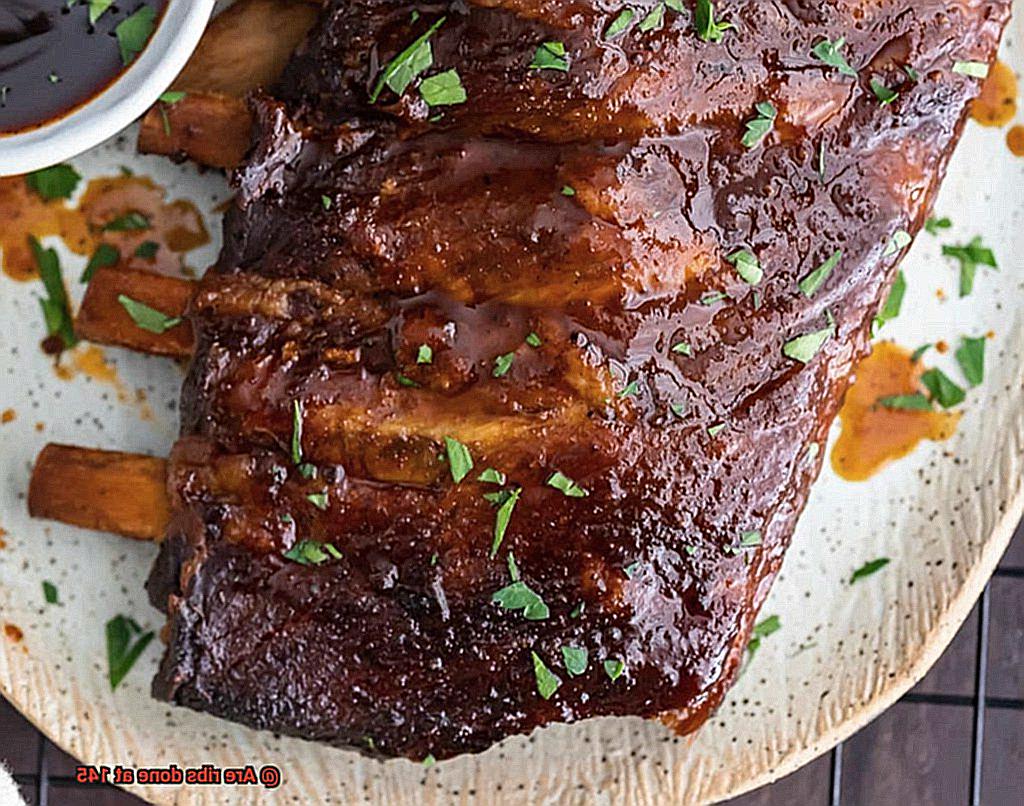
Grilling or oven-roasting your ribs? No problem. Set your grill or oven to a similar temperature range and place the ribs away from direct heat. This indirect heat method ensures that the ribs cook evenly and retain their juiciness.
Monitoring the Temperature:
Investing in a good meat thermometer is crucial to achieving perfectly cooked ribs. Insert the thermometer into the thickest part of the meat without touching the bone for an accurate reading. This way, you can monitor the internal temperature throughout the cooking process and ensure your ribs are cooked to perfection.
Beyond Temperature: Seasoning, Marinating, and Resting:
While temperature plays a vital role in cooking ribs, don’t forget about other aspects that contribute to their flavor and tenderness. Before cooking, apply a delicious dry rub or marinade to enhance the taste of your ribs. Let them rest for a few minutes after cooking to allow the juices to redistribute, ensuring maximum flavor and succulence.
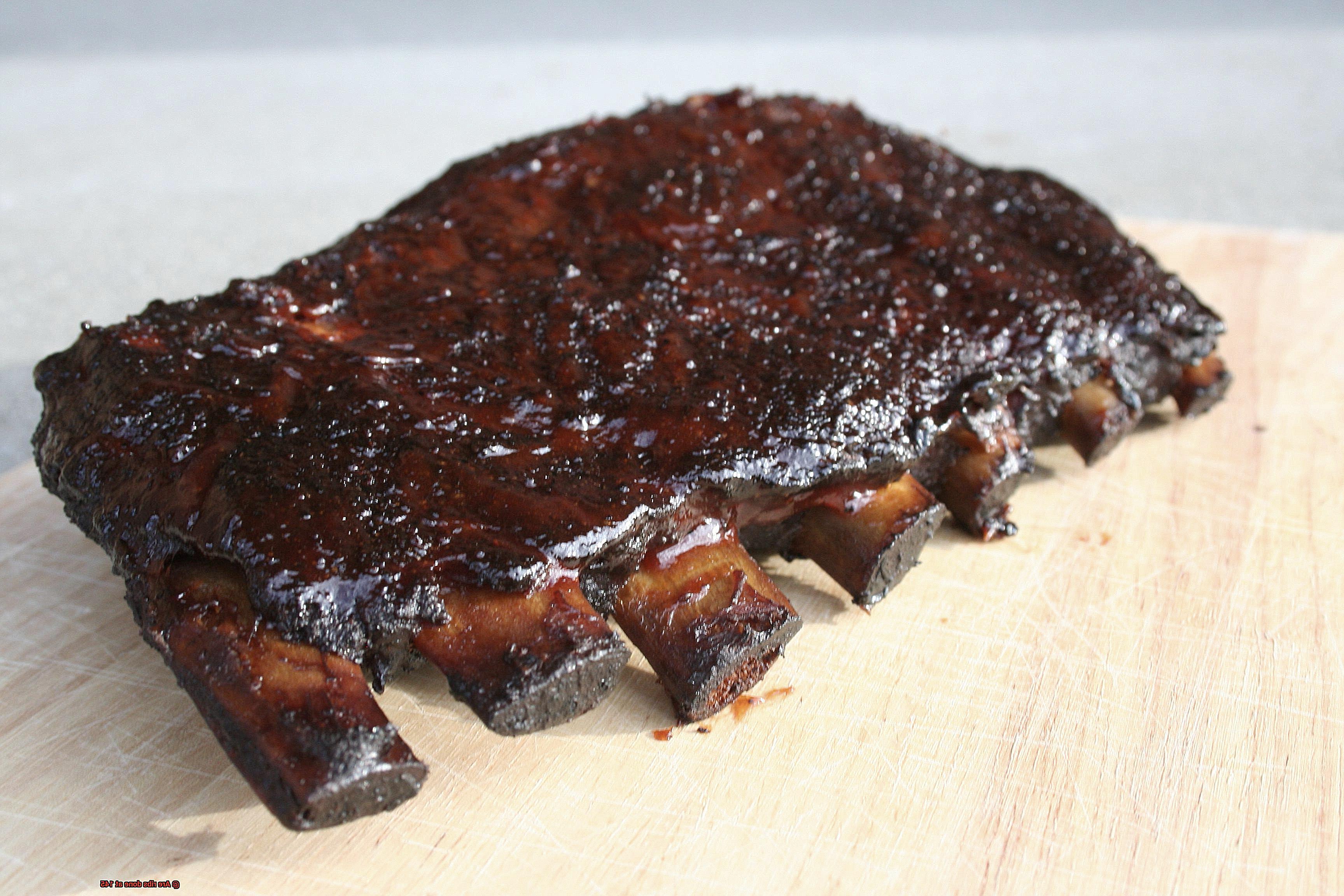
Different Cooking Methods and Their Recommended Temperatures
Brace yourselves for an exhilarating journey to become a true rib master. Today, we are delving into the realm of different cooking methods for ribs and their recommended temperatures. Whether you are a charcoal purist or a gas grilling aficionado, prepare to unlock the secrets that will elevate your rib game. So, grab hold of your tongs, ignite the flames, and let’s embark on a culinary adventure.
Grilling:
Let’s start with the timeless art of grilling. Imagine succulent ribs, seared to perfection, boasting an irresistible smoky flavor. To achieve this masterpiece, maintain a steady temperature between 225°F to 250°F (107°C to 121°C). This low and slow approach will ensure that your baby back ribs reach a tender texture while retaining their natural flavors.
Smoking:
Ready to take your grilling prowess to unparalleled heights? Enter the captivating world of smoking. By infusing your ribs with the enchanting essence of wood smoke, you will create a taste sensation like no other. Traditional barbecue smokers work their magic at lower temperatures, around 225°F (107°C). However, dare to venture into higher temperatures up to 275°F (135°C) for a shorter cooking time. Whichever path you choose, aim for an internal temperature between 190°F to 203°F (88°C to 95°C) for fall-off-the-bone goodness.
Oven Roasting:
No grill? No worries. Oven roasting emerges as a splendid alternative for cooking ribs. Preheat your oven to approximately 275°F (135°C), place the ribs on a baking sheet or in a roasting pan, and let them slowly cook for about 2 to 3 hours. This method grants you the same tenderness as smoking without the need for an outdoor setup.
Sous Vide:
Seeking a culinary adventure? Welcome to the captivating world of sous vide. This technique involves sealing your ribs in an airtight bag and cooking them in a water bath at precisely controlled temperatures. For ribs, we recommend around 145°F (63°C) for medium-rare or 165°F (74°C) for medium doneness. Though unconventional for ribs, rest assured that this method yields meat so tender and juicy, it will leave you awe-struck.
Braising:
Last but certainly not least, let us explore the intriguing art of braising. This method entails searing your ribs on the stovetop before gently simmering them in a flavorful liquid. Set your oven to approximately 325°F (163°C) and let the magic unfold for 2 to 3 hours. The result? Ribs so tender they practically melt in your mouth, leaving you craving more.
The Importance of Using a Meat Thermometer
Now, we’re going to delve into the world of grilling and uncover a secret weapon every backyard chef should wield – the meat thermometer. Now, you might be thinking, “Why bother with a thermometer? I’ve got this grilling thing down.” But trust me, my friend, using a meat thermometer when cooking ribs is a game-changer that will elevate your grill game to new heights.
First and foremost, let’s talk food safety. Undercooked meat is no laughing matter. It’s a breeding ground for nasty bacteria like salmonella or E. coli, just waiting to ruin your day. By checking the internal temperature of your ribs, you can ensure they reach the safe zone of 145°F (63°C) for pork. This simple act eliminates any potential health risks and keeps your loved ones safe and sound.
But it’s not just about safety – it’s about achieving perfection. No one wants to sink their teeth into a tough, overcooked rib or, heaven forbid, a raw one. With a meat thermometer in hand, you become the master of doneness and tenderness. By monitoring the internal temperature, you can hit that sweet spot of juicy perfection. Aim for around 195°F (90°C) for fall-off-the-bone goodness that will make your taste buds sing.
Now, let’s address the issue of inconsistency. Have you ever had one rack of ribs turn out flawlessly while another was disappointingly dry or undercooked? It’s enough to make even the most seasoned griller throw in the apron. But fear not. The meat thermometer is here to save the day. No more guesswork – just consistent results every single time. Say goodbye to culinary disappointments and hello to grilling glory.
But wait, there’s more. Let’s explore the world of meat thermometers. There are instant-read thermometers, providing quick and accurate readings in mere seconds. Perfect for checking the final temperature of your ribs. Then there are leave-in thermometers, those trusty companions you insert into the meat and monitor throughout the cooking process. Ideal for longer cooking methods like smoking or roasting.
Using a meat thermometer is as easy as pie. Simply insert it into the thickest part of the rib, making sure to avoid the bone. Wait a few seconds until the temperature stabilizes, and voila. You have an accurate reading of your rib’s doneness. It’s like having your culinary detective, ensuring you never serve a subpar rib again.
Imagine the satisfaction of presenting perfectly cooked ribs to your guests – each bite tender, juicy, and bursting with flavor. Plus, you’ll have the peace of mind knowing that you’ve eliminated any potential health risks associated with undercooked meat. So let’s raise our tongs and make a solemn vow – never shall we grill another rib without our trusty meat thermometer by our side. Happy grilling, my friends.
Visual Cues for Determining Doneness
We’re about to unveil the secrets to determining if your ribs are cooked to perfection at a sizzling temperature of 145 degrees Fahrenheit. Grab your tongs and don your apron, because it’s time to become a rib-grilling virtuoso.
Let’s start with the mesmerizing color of the meat. When your ribs are fully cooked, they should flaunt a glorious golden brown hue on the outside. This captivating transformation is thanks to the Maillard reaction, where proteins and sugars in the meat dance with heat, creating that mouthwatering crust we all crave.
But don’t stop there – let’s delve into texture. Picture this: perfectly cooked ribs should be tender and juicy, with the meat effortlessly parting from the bone. To test this, simply grasp a rib rack with your trusty tongs and gently lift from one end. If it gracefully bends and the meat starts to separate from the bone, you know you’re on the path to rib nirvana.
Now, let’s talk about those grill marks. As you cook your ribs on a scorching grill, they often develop those tantalizing charred lines. Not only do these marks contribute to the flavor, but they also signify that your ribs have been seared at high heat, infusing them with irresistible smoky goodness. However, remember that grill marks alone cannot determine doneness, so don’t rely solely on their mesmerizing presence.
And last but certainly not least, let’s talk about caramelization. As your ribs cook, the sugars in the meat undergo a delectable transformation, creating a sticky and sweet glaze on the surface. This not only adds an incredible depth of flavor but also enhances the visual appeal of your ribs.
But before you place all your trust in visual cues, it’s important to mention the importance of using a meat thermometer. The USDA recommends cooking pork to a minimum internal temperature of 145 degrees Fahrenheit, followed by a three-minute rest period. This ensures that any potential harmful bacteria are vanquished while leaving you with succulent and flavorsome ribs.
Tips for Achieving Perfectly Cooked Ribs at Various Levels of Doneness
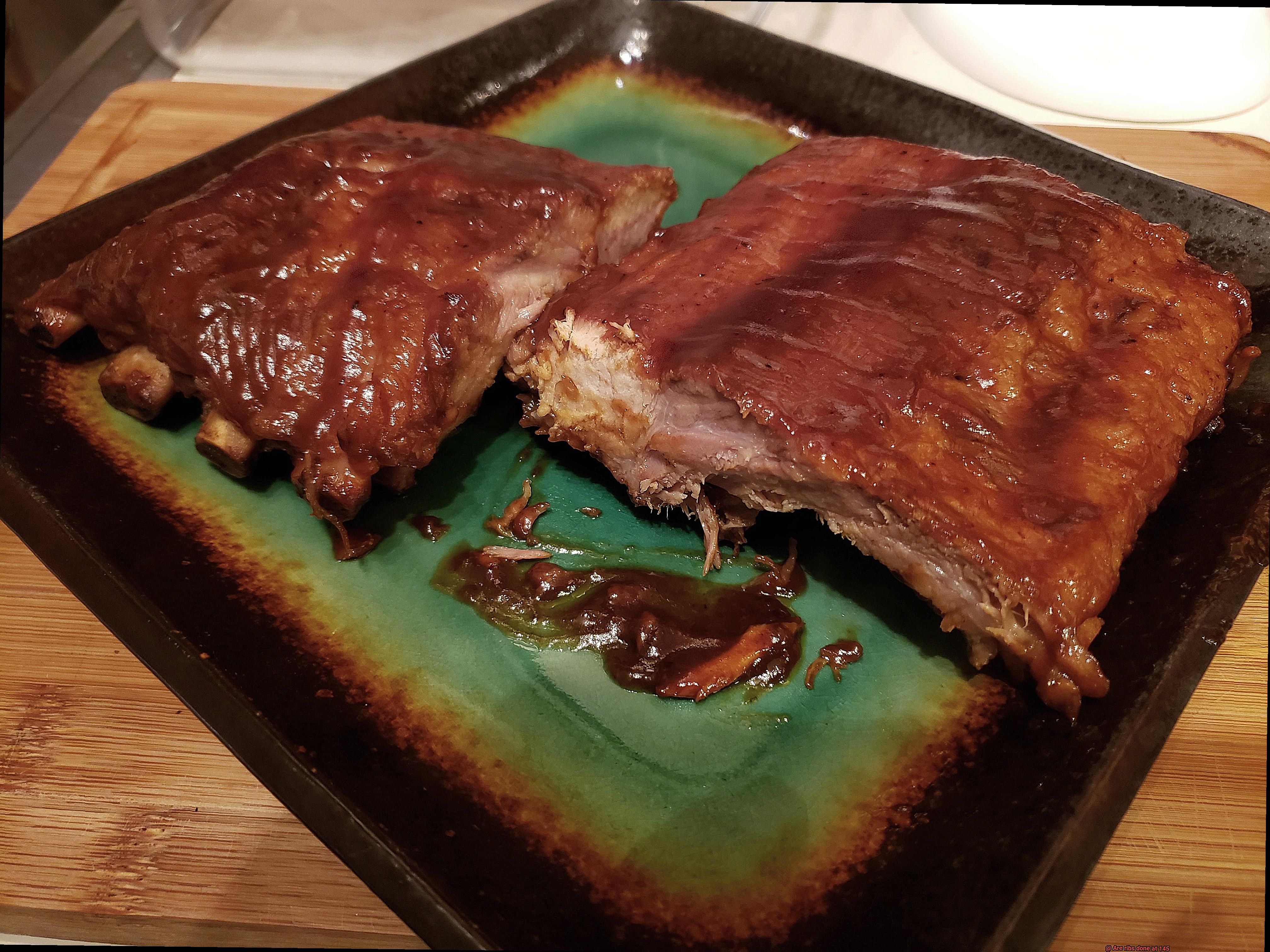
Grilling ribs to perfection can be a challenging task, especially when it comes to achieving the ideal level of doneness. Whether you prefer fall-off-the-bone tender or a little bit of chewiness, this article will provide you with valuable tips and guidelines for cooking ribs at 145 degrees Fahrenheit. So fire up your grill, grab your tongs, and get ready to impress your family and friends with mouthwatering ribs.
Determining the Level of Doneness:
Before you start grilling your ribs, it’s crucial to determine the level of doneness that suits your taste buds. While the USDA recommends cooking pork to an internal temperature of 145°F (63°C), keep in mind that this may not be the desired level of doneness for everyone. Cooking ribs beyond 145°F can result in a more tender and flavorful outcome, so don’t be afraid to experiment.
Using a Reliable Meat Thermometer:
To ensure perfectly cooked ribs, invest in a reliable meat thermometer. Insert it into the thickest part of the meat without touching the bone for accurate readings. For fall-off-the-bone tender ribs, aim for an internal temperature between 195°F and 203°F (90°C – 95°C). If you prefer a bit of chewiness, aim for around 165°F (74°C).
Choosing the Right Cooking Method:
The cooking method you choose can greatly affect the level of doneness of your ribs. Consider grilling over direct heat for a quicker cooking time and a slightly charred exterior. Smoking over indirect heat at a lower temperature will result in a more tender and smoky flavor. Oven baking allows for precise temperature control and even cooking.
Enhancing Flavor and Tenderness:
To take your ribs to the next level, use a marinade or dry rub. Marinades tenderize the meat and infuse it with flavor, while dry rubs create a flavorful crust during cooking. Experiment with various marinades, such as barbecue sauce, herbs, spices, or even a citrus-based mixture. Apply the marinade or dry rub evenly and let the flavors work their magic.
Mastering Proper Cooking Techniques:
To achieve perfectly cooked ribs, practice proper cooking techniques. For grilling, start by searing the ribs over high heat to lock in the juices. Then, reduce the heat to medium and continue cooking until they reach the desired doneness. If smoking, maintain a consistent temperature and baste the ribs occasionally to keep them moist. When oven baking, use a low and slow method for maximum tenderness.
Resting the Ribs After Cooking
Cooking ribs to perfection requires skill, patience, and attention to detail. One often overlooked step that can make a significant difference in the final result is resting the ribs after they’ve been cooked. In this article, we will explore why resting ribs is crucial for achieving tender, flavorful meat, and provide tips on how to do it properly.
The Science Behind Resting:
When ribs are cooked, the heat causes the proteins in the meat to contract, pushing out the natural juices. Cutting into the ribs immediately after cooking would cause these flavorful juices to escape, resulting in dry and less tasty meat. By allowing the ribs to rest, you give the proteins a chance to relax and reabsorb those juices, resulting in moist and succulent ribs.
The Perfect Resting Time:
To achieve optimal results, it is recommended to let the ribs rest for about 10 to 15 minutes. This allows for proper redistribution of the juices without letting the meat cool down too much. Resting for too long may cause the ribs to become lukewarm or even cold, impacting the overall eating experience.
Covering for Success:
During the resting process, it is important to cover the ribs loosely with aluminum foil or a clean kitchen towel. This helps retain some heat and prevents excessive moisture evaporation from the surface of the meat. However, avoid sealing them tightly as this can create a steaming effect and lead to soggy ribs.
Maximizing Flavor and Convenience:
While your ribs are resting, take advantage of this time to prepare any additional sauces or sides that will accompany your meal. By doing so, everything will be ready to serve when it’s time to eat. Additionally, resting allows you to avoid any last-minute chaos in the kitchen and fully enjoy your perfectly cooked and rested ribs.
How to Properly Sauce and Serve Ribs
Grilling season is upon us, and there’s nothing quite like sinking your teeth into a slab of ribs that are perfectly sauced and served. If you want to take your grilling skills to the next level and impress your family and friends with mouthwatering ribs, then this guide is for you. We’ll take you through the steps to choose the right sauce, apply it to the ribs, cook them to perfection, and serve them in style.
Choose Your Sauce:
Embark on a flavor journey by selecting the perfect sauce for your ribs. Are you craving a sweet and tangy explosion or a spicy and smoky sensation? With a wide variety of sauces available, there’s one out there to suit every taste bud. Consider the flavor profile you want to achieve and choose a sauce that complements it well.
Apply the Sauce:
Now that you have your chosen sauce ready, it’s time to coat those ribs in deliciousness. Grab a basting brush or use your hands for a more hands-on experience. Be generous as you slather both sides of the ribs with the sauce, ensuring that every nook and cranny is covered for an explosion of flavor in every bite.
Cook ‘Em Up:
The magic truly happens when those sauced ribs hit the grill. Preheat it to medium heat and place the ribs directly on the grates. Listen to the sizzle as the flavors come alive. Let them cook for about 10-15 minutes per side until the sauce caramelizes, creating a sticky glaze that enhances the smoky flavors infused in the meat. If you prefer other cooking methods like using an oven or slow cooker, follow the recommended cooking times for tender and succulent ribs.
Rest and Slice:
Patience is key when it comes to serving up those tantalizing ribs. Once they’re cooked to perfection, transfer them to a cutting board and resist the temptation to dive right in. Let them rest for a few minutes, allowing the juices to redistribute throughout the meat. This results in juicy and flavorful ribs that will make your taste buds sing. When the time is right, grab a sharp knife and slice between the bones to create individual servings.
Presentation is Everything:
To elevate your sauced ribs even further, it’s all about the presentation. Arrange them on a platter, taking care to make them look as irresistible as they taste. Add a touch of vibrancy with a garnish of fresh herbs like parsley or cilantro. This burst of freshness adds another layer of flavor complexity to your already delectable creation. For extra indulgence, serve with extra sauce on the side for dipping.
Yx2PbhS9YD4″ >
Conclusion
When it comes to cooking ribs, there is a common misconception that they are done when they reach an internal temperature of 145 degrees Fahrenheit. However, this temperature might not be sufficient to achieve the desired tenderness and flavor that we associate with perfectly cooked ribs.
To truly elevate your rib game, it is recommended to cook them low and slow at a temperature of around 225-250 degrees Fahrenheit. This allows the collagen in the meat to break down slowly, resulting in tender, fall-off-the-bone goodness.
While it is essential to monitor the internal temperature of your ribs for food safety reasons, relying solely on the 145-degree mark can lead to disappointment. Instead, aim for an internal temperature of around 195-203 degrees Fahrenheit. At this point, you can be confident that your ribs are truly done and ready to be devoured.
Remember, cooking ribs is an art form that requires patience and attention to detail. Don’t rush the process; let those flavors develop and intensify over time. Your taste buds will thank you for it.
So next time you’re firing up the grill or preheating your oven for some mouthwatering ribs, remember that 145 degrees might not cut it. Take your time, embrace the low and slow method, and aim for that magical internal temperature range of 195-203 degrees Fahrenheit. Your reward will be succulent, juicy ribs that will have everyone begging for seconds.
In conclusion, while 145 degrees may be safe from a food safety perspective, true rib perfection lies beyond this threshold. So go ahead and elevate your rib game by embracing proper cooking techniques and aiming for that ideal internal temperature range.

